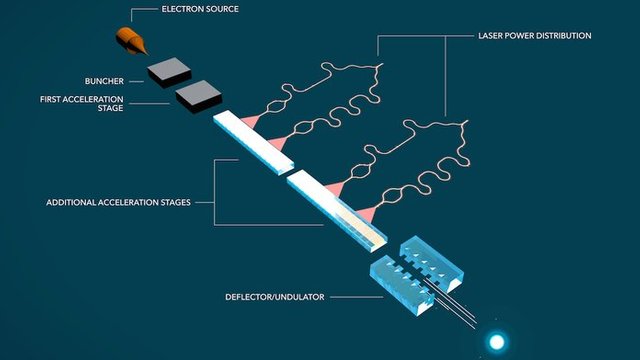A New Laser ExpeRiment ShowS ElecTrons can be StoPPed with LighT 💡
By striking electrons accelerated by plasma with an ultra-intense laser, researchers have discovered dynamics that go beyond classical physics and suggest quantum effects, finding for the first time the experimental evidence of the effect of radiation reaction.
Credits
When light hits an object, it is partly reflected by the surface of the object itself, but if the object is moving at an extremely high speed, and if the light is incredibly intense, strange things can happen. Things that classical physics can not explain. This is how and moving electrons struck by a very intense light, contrary to what one might think, end up slowing their motion, because induced to radiate the incident energy, very high. Physicists call this ‘radiation reaction’.
This phenomenon is commonly thought to occur around compact objects such as black holes and quasars (supermassive black holes surrounded by a gas disk). Therefore, being able to measure the reaction to radiation in the laboratory would allow us to obtain information on the processes that occur in some of the most extreme environments in the universe and understand the nature of this phenomenon is also interesting for physicists who study effects not explained by the classical physics, since the equations that traditionally define the forces acting on objects (known as Maxwell equations) do not allow to describe such extreme environments. Although there are several models to describe the motion of particles and the emission of photons in this regime, the radiation reaction has never been observed directly before.
For the first time, a team of researchers led by Imperial College London performed an experiment designed to amplify the effects of the radiation reaction to a measurable level, and concluded that this phenomenon is needed to explain the observed results, published yesterday in the journal Physical Review X .
The researchers observed this reaction to radiation by colliding a laser beam a quadrillion (one million billion) times more intense than light at the surface of the Sun, with a beam of high-energy electrons. The team was able to make the incident light so intense by concentrating it on a very small point (just a few micrometers, or millionths of a meter) and providing all the energy in a very short time (only 40 femtoseconds, or 40 quadrillion second ). To make the electron beam small enough to interact with the focused laser, the team used a technique called Plasma acceleration, which accelerates electrons using laser waves driven by laser pulses, as if electrons surfed on the plasma waves. The experiment, which required extreme precision and excellent synchronization, was conducted using the Gemini laser at the Science and Technology Facilities Council Central Laser Facility in the United Kingdom.
Credits
The photons of light reflected by an object moving at a speed close to that of light have an energy greater than those incident. In the extreme conditions reproduced in this experiment, this causes the light to pass from the visible (incident rays) to high-energy gamma rays (reflected rays). This allowed the researchers to know when the laser had actually hit the electron beam.
Stuart Mangles from the Department of Physics at Imperial College, author of the paper, said:
"We knew we had success in colliding the two beams when we detected high-energy gamma radiation."
But the real and great result came when the energy of the electron beam was measured after the collision , finding that it was lower than expected or, in other words, that the electrons had slowed their motion , clear evidence of the reaction to radiation . The co-author of the study, Alec Thomas , of Lancaster University and the University of Michigan , commented on the discovery:
"I find it extremely fascinating that the electrons are actually stopped by a sheet of light as thick as a fraction of a hair, as a millimeter of lead. It's really extraordinary. "
Credits
The data obtained from the experiment better agree with a theoretical model based on the principles of quantum electrodynamics, rather than on Maxwell's equations, potentially providing some of the first tests of quantum models not yet tested. Professor Mattias Marklund of Chalmers University of Technology, in Sweden, whose group was involved in the study, said:
“Testing our theoretical forecasts is of fundamental importance to us, especially in the new regimes where there is still much to learn. Together with the theory, these experiments are the basis of research on high-intensity lasers in the quantum domain”.
Further experiments will be needed with even greater intensities and with even higher electron beams of energy to confirm the result found, which will be carried out by the same team during the next year.
References For Further Reading
Big Thanks to @enginewitty for this cool Badge



As a follower of @followforupvotes this post has been randomly selected and upvoted! Enjoy your upvote and have a great day!
You got a 4.10% upvote from @buildawhale courtesy of @afifa!
If you believe this post is spam or abuse, please report it to our Discord #abuse channel.
If you want to support our Curation Digest or our Spam & Abuse prevention efforts, please vote @themarkymark as witness.
Your post had been curated by the @buildawhale & @ipromote team and mentioned here:
https://steemit.com/curation/@buildawhale/buildawhale-curation-digest-02-12-18
Keep up the good work and original content, everyone appreciates it!
I am so honored 😁